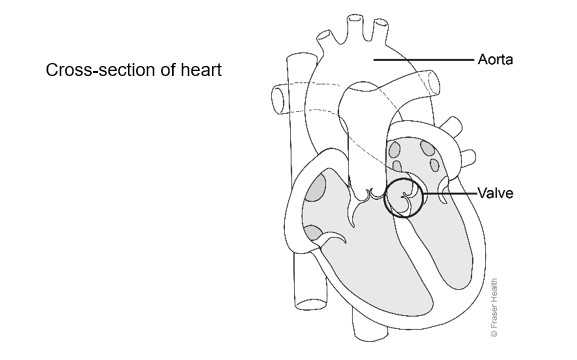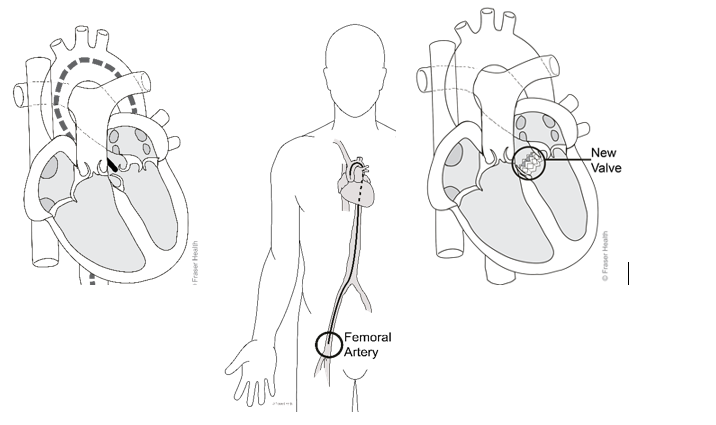Transcatheter aortic valve implantation (TAVI) is a minimally invasive procedure used to treat aortic valve disease of the heart.
Why would I need a new aortic valve?
The aortic valve is one of four valves in your heart. These valves keep blood flowing in the right direction through your heart. When your heart beats, blood is pumped out of the heart through the aortic valve to the rest of your body.
When the aortic valve is not working properly it can be either too tight (not opening easily), which we call aortic stenosis, or too leaky (does not close properly), which we call aortic regurgitation.
Aortic stenosis is more common than aortic regurgitation. In some people, as they age, the valve becomes stiff and the blood has more and more trouble being pumped through the opening. When this happens, it can cause a person to feel short of breath, have chest pain, and/or feel faint or very tired.
How is aortic stenosis treated?
Aortic stenosis is a problem with the movement and function of the valve. The only way to relieve the stenosis is to replace the valve. There are two options for replacing the valve: surgical aortic valve replacement and transcatheter aortic valve implantation (TAVI).
Surgical aortic valve replacement, also called open heart surgery, is a well-established procedure. During surgical aortic valve replacement, the surgeon opens your chest, connects you to a heart-lung machine to pump blood around your body, removes your diseased aortic valve and replaces it with a new valve. The procedure delivers excellent results, but it can take three to six months to recover from this surgery. For the right patient, surgical aortic valve replacement is a good choice of treatment for aortic valve disease.
Transcatheter aortic valve implantation is a newer procedure for replacing aortic valves, and the advantage is that it can be easier to recover from. It may be a better option if:
- You are older than 80 years and have health problems like kidney disease, lung disease, or cancer that can limit your ability to recover easily from open heart surgery
- You have had one or more open heart surgeries in the past
- You are not well enough to have open heart surgery because of a health condition such as kidney disease or stroke
- The heart valve team agrees that TAVI is the right treatment for you
What is a TAVI (transcatheter aortic valve implantation)?
Transcatheter means through a catheter. A catheter is a long, thin, flexible, hollow tube. Aortic is the name of the heart valve where the aorta attaches to the heart. Valve is the part of the heart that opens and closes when the heart beats. Implantation means to implant or place a new heart valve.
The procedure is done by attaching the new valve to the end of the catheter. The catheter is then threaded up into your heart through a large artery in your groin called the femoral artery. Health providers use X-ray images to help guide the catheter to your heart and aortic valve. Once in the right location, the new valve is implanted, and the catheter is removed. Unlike open heart surgery, you are usually awake for the procedure, there is no need for the heart lung machine, and there are no large surgical incisions.
The video below explains more about the TAVI procedure:
How do I know if I am eligible for a TAVI procedure?
To determine if TAVI is the right treatment for you, we need to gather a lot of information about your heart and your health. You can expect your doctor to order several tests including an electrocardiogram, echocardiogram, computed tomography (CT) scan, and angiogram.
After testing, you would be contacted by the TAVI coordinator who will make you an appointment to come to the TAVI clinic for an assessment. Following your tests and appointment, the heart valve team will meet to review the results of your assessment and heart tests. From this, they determine the best way to treat your aortic valve disease. The heart valve team will contact you and your family to discuss the next steps.
You can read more about TAVI procedures in Fraser Health in this article, "Great step forward for heart patients" or read about the experience of one of our patients.
Resources
The following resources provide more information on transcatheter aortic valve implantation:
-
Transcatheter Aortic Valve Implantation - An option for treating aortic stenosis
-
HealthLink BC: Transcatheter aortic valve implantation and replacement
- HealthLink BC: Minimally invasive heart surgery
- Cardiac Services BC: Treatment services for structural heart disease
- Ottawa Heart Institute: Transcatheter aortic valve implantation
- Fraser Health Patient Education: Deciding to have a transcatheter aortic valve implantation
- Fraser Health Patient Education: After a transcatheter aortic valve implantation


